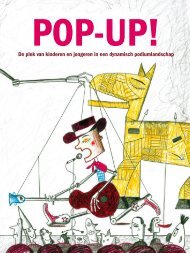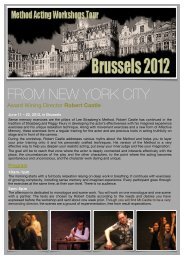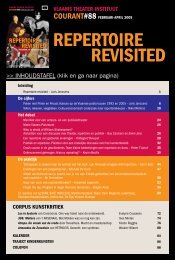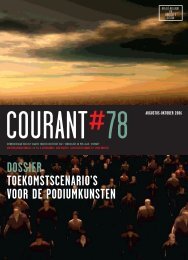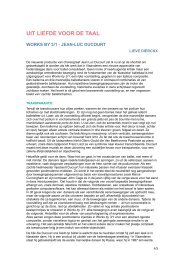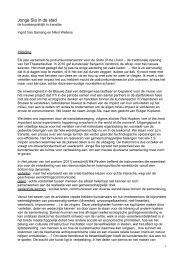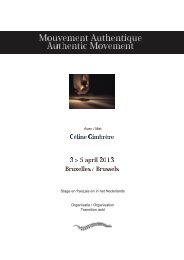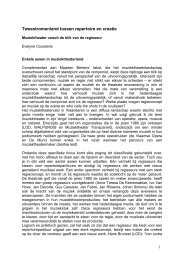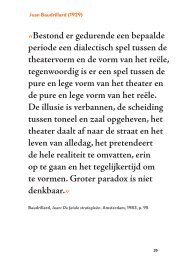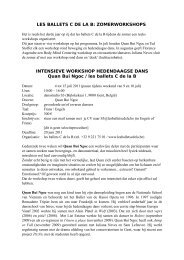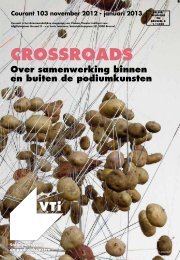music theatre in flanders - Muziekcentrum Vlaanderen
music theatre in flanders - Muziekcentrum Vlaanderen
music theatre in flanders - Muziekcentrum Vlaanderen
Create successful ePaper yourself
Turn your PDF publications into a flip-book with our unique Google optimized e-Paper software.
In the ramified <strong>music</strong> <strong>theatre</strong> landscape <strong>in</strong> Flanders a lot of<br />
people, or smaller groups of artists, practise <strong>music</strong> <strong>theatre</strong> a bit<br />
on their own, without the protection of some major organization,<br />
and – sadly enough – often <strong>in</strong> greater anonymity. Still, these <strong>in</strong>itiatives<br />
are precious, because they are often <strong>in</strong>novative and therefore<br />
deserve support. Most of them receive project subsidies. I believe<br />
it is absolutely necessary that they will be able to cont<strong>in</strong>ue work<strong>in</strong>g,<br />
next to and apart from the lager organizations. Moreover, I<br />
am fond of the image of the artist as an – artistically – autonomous<br />
<strong>in</strong>dividual, <strong>in</strong>dependent from any organization whatsoever.<br />
A strik<strong>in</strong>g parallel between the world of <strong>music</strong> and the world<br />
of <strong>music</strong> <strong>theatre</strong> has occurred to me. Ever s<strong>in</strong>ce the 1960s (or<br />
sometime then) composers of classical <strong>music</strong> (‘classical’ – but the<br />
partitions are disappear<strong>in</strong>g here as well) have <strong>in</strong>creas<strong>in</strong>gly been<br />
turn<strong>in</strong>g back to ensembles, show<strong>in</strong>g a tendency to abandon the<br />
symphonic orchestra and the standardized chamber <strong>music</strong> <strong>in</strong>strumentation.<br />
By choos<strong>in</strong>g a dist<strong>in</strong>ctly contemporary ensemble,<br />
that can be characterized by a l<strong>in</strong>e up of s<strong>in</strong>gle solo <strong>in</strong>struments<br />
(unlike, for <strong>in</strong>stance, the symphonic orchestra, where each <strong>in</strong>strument<br />
has a multiple presence), contemporary composers try to<br />
avoid the standardized, orig<strong>in</strong>ally 18 th and 19 th -century <strong>in</strong>strumentations,<br />
rang<strong>in</strong>g from piano qu<strong>in</strong>tet to symphonic orchestra. What<br />
they want is a small-scale form of mak<strong>in</strong>g <strong>music</strong> <strong>in</strong> which the <strong>in</strong>dividual<br />
contacts between <strong>music</strong>ians and composer are easier to<br />
establish and more direct, avoid<strong>in</strong>g the overall hierarchic <strong>music</strong>al<br />
structures we know from, for <strong>in</strong>stance, the symphonic orchestra,<br />
though there will, admittedly, also be economic reasons.<br />
This tendency rem<strong>in</strong>ds me of the emergence, also <strong>in</strong> the<br />
1960s, of small-scale <strong>music</strong> <strong>theatre</strong>, <strong>in</strong> which the makers work<br />
together very closely without hav<strong>in</strong>g to ‘give account’ to a larger<br />
structure they are part of. In that context, close collaboration between<br />
all makers implies, for <strong>in</strong>stance, that the composer is allowed<br />
to take part <strong>in</strong> establish<strong>in</strong>g the dramatic content, and that<br />
he can br<strong>in</strong>g <strong>in</strong> his ideas about purely theatrical issues, or that<br />
someone like the text writer, who is often also the director, can<br />
have a strong impact on the composer’s writ<strong>in</strong>g of the <strong>music</strong>. In<br />
this context, the fixed traditional libretto-<strong>music</strong>-stage designdirection–rehearsal<br />
sequence is replaced by a rather concentric<br />
and highly organic approach, <strong>in</strong> which the various art discipl<strong>in</strong>es<br />
simultaneously <strong>in</strong>teract and shape the <strong>music</strong> <strong>theatre</strong> piece. This<br />
approach has many advantages and is, from an artistic po<strong>in</strong>t of<br />
view, often very challeng<strong>in</strong>g as a work process (and highly unpredictable),<br />
but there are, of course, also some setbacks. The<br />
f<strong>in</strong>al artistic product is so closely connected to its makers and<br />
the various art discipl<strong>in</strong>es are so tightly <strong>in</strong>terwoven, that a reprise<br />
with new personnel will, as it were, be a new work. And that is,<br />
on all accounts, a very significant difference from opera – even<br />
contemporary opera.<br />
bIG ánd SMAll<br />
To me, as a composer, work<strong>in</strong>g for <strong>music</strong> <strong>theatre</strong> is a very challeng<strong>in</strong>g<br />
and enrich<strong>in</strong>g artistic occupation. Sometimes, of course,<br />
I wonder how <strong>music</strong> written for contemporary small-scale <strong>music</strong><br />
<strong>theatre</strong> can be evaluated. This so-called ‘functionality’ rema<strong>in</strong>s a<br />
hot potato when it comes to judg<strong>in</strong>g the quality of <strong>music</strong> written<br />
for <strong>music</strong> <strong>theatre</strong>. I th<strong>in</strong>k it is odd that the <strong>music</strong> should be isolated<br />
from the artistic work as a whole (the <strong>music</strong> <strong>theatre</strong> piece)<br />
for and as a part of which it was conceived. Autonomy can, for me,<br />
be no criterion to evaluate the quality of <strong>music</strong>. In fact, we should<br />
simply apply the criteria used for concert <strong>music</strong>: orig<strong>in</strong>ality, <strong>music</strong>al<br />
imag<strong>in</strong>ation and <strong>in</strong>ventiveness…<br />
Still, I have to admit: too often, theatrical tricks are used as<br />
an adroit, though extremely irritat<strong>in</strong>g, camouflage to hide the<br />
lack of <strong>music</strong>al imag<strong>in</strong>ation. A composer who takes writ<strong>in</strong>g for<br />
72 73<br />
table of contents



